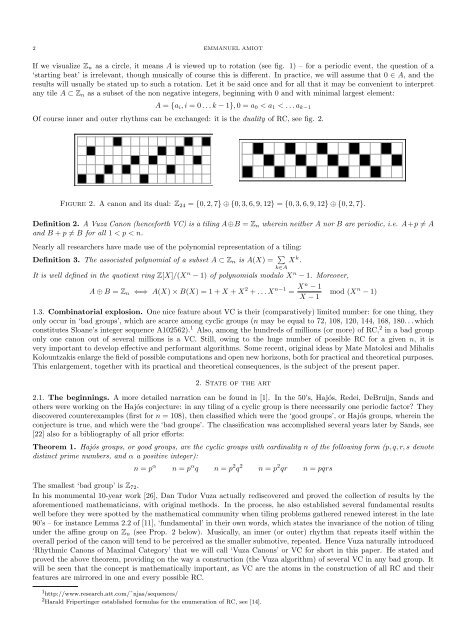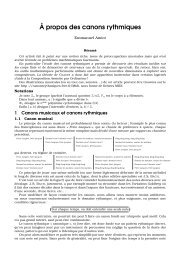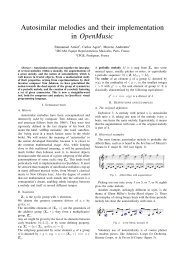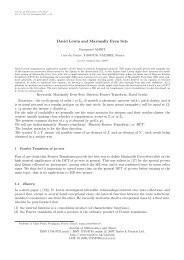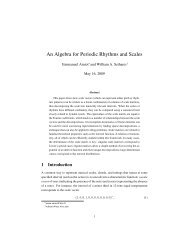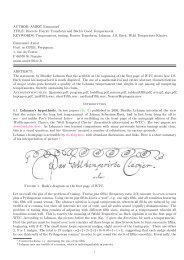Emmanuel Amiot Modèles algébriques et algorithmes pour la ...
Emmanuel Amiot Modèles algébriques et algorithmes pour la ...
Emmanuel Amiot Modèles algébriques et algorithmes pour la ...
Create successful ePaper yourself
Turn your PDF publications into a flip-book with our unique Google optimized e-Paper software.
2 EMMANUEL AMIOT<br />
If we visualize Zn as a circle, it means A is viewed up to rotation (see fig. 1) – for a periodic event, the question of a<br />
‘starting beat’ is irrelevant, though musically of course this is different. In practice, we will assume that 0 ∈ A, and the<br />
results will usually be stated up to such a rotation. L<strong>et</strong> it be said once and for all that it may be convenient to interpr<strong>et</strong><br />
any tile A ⊂ Zn as a subs<strong>et</strong> of the non negative integers, beginning with 0 and with minimal <strong>la</strong>rgest element:<br />
A = {ai, i = 0 . . . k − 1}, 0 = a0 < a1 < . . . ak−1<br />
Of course inner and outer rhythms can be exchanged: it is the duality of RC, see fig. 2.<br />
Figure 2. A canon and its dual: Z24 = {0, 2, 7} ⊕ {0, 3, 6, 9, 12} = {0, 3, 6, 9, 12} ⊕ {0, 2, 7}.<br />
Definition 2. A Vuza Canon (henceforth VC) is a tiling A⊕B = Zn wherein neither A nor B are periodic, i.e. A+p = A<br />
and B + p = B for all 1 < p < n.<br />
Nearly all researchers have made use of the polynomial representation of a tiling:<br />
Definition 3. The associated polynomial of a subs<strong>et</strong> A ⊂ Zn is A(X) = <br />
Xk .<br />
It is well defined in the quotient ring Z[X]/(X n − 1) of polynomials modulo X n − 1. Moreover,<br />
A ⊕ B = Zn ⇐⇒ A(X) × B(X) = 1 + X + X 2 + . . . X n−1 = Xn − 1<br />
X − 1 mod (Xn − 1)<br />
1.3. Combinatorial explosion. One nice feature about VC is their (comparatively) limited number: for one thing, they<br />
only occur in ‘bad groups’, which are scarce among cyclic groups (n may be equal to 72, 108, 120, 144, 168, 180. . . which<br />
constitutes Sloane’s integer sequence A102562). 1 Also, among the hundreds of millions (or more) of RC, 2 in a bad group<br />
only one canon out of several millions is a VC. Still, owing to the huge number of possible RC for a given n, it is<br />
very important to develop effective and performant algorithms. Some recent, original ideas by Mate Matolcsi and Mihalis<br />
Kolountzakis en<strong>la</strong>rge the field of possible computations and open new horizons, both for practical and theor<strong>et</strong>ical purposes.<br />
This en<strong>la</strong>rgement, tog<strong>et</strong>her with its practical and theor<strong>et</strong>ical consequences, is the subject of the present paper.<br />
2. State of the art<br />
2.1. The beginnings. A more d<strong>et</strong>ailed narration can be found in [1]. In the 50’s, Hajós, Redei, DeBruijn, Sands and<br />
others were working on the Hajós conjecture: in any tiling of a cyclic group is there necessarily one periodic factor? They<br />
discovered counterexamples (first for n = 108), then c<strong>la</strong>ssified which were the ‘good groups’, or Hajós groups, wherein the<br />
conjecture is true, and which were the ‘bad groups’. The c<strong>la</strong>ssification was accomplished several years <strong>la</strong>ter by Sands, see<br />
[22] also for a bibliography of all prior efforts:<br />
Theorem 1. Hajós groups, or good groups, are the cyclic groups with cardinality n of the following form (p, q, r, s denote<br />
distinct prime numbers, and α a positive integer):<br />
n = p α<br />
n = p α q n = p 2 q 2<br />
k∈A<br />
n = p 2 qr n = pqrs<br />
The smallest ‘bad group’ is Z72.<br />
In his monumental 10-year work [26], Dan Tudor Vuza actually rediscovered and proved the collection of results by the<br />
aforementioned mathematicians, with original m<strong>et</strong>hods. In the process, he also established several fundamental results<br />
well before they were spotted by the mathematical community when tiling problems gathered renewed interest in the <strong>la</strong>te<br />
90’s – for instance Lemma 2.2 of [11], ‘fundamental’ in their own words, which states the invariance of the notion of tiling<br />
under the affine group on Zn (see Prop. 2 below). Musically, an inner (or outer) rhythm that repeats itself within the<br />
overall period of the canon will tend to be perceived as the smaller submotive, repeated. Hence Vuza naturally introduced<br />
‘Rhythmic Canons of Maximal Category’ that we will call ‘Vuza Canons’ or VC for short in this paper. He stated and<br />
proved the above theorem, providing on the way a construction (the Vuza algorithm) of several VC in any bad group. It<br />
will be seen that the concept is mathematically important, as VC are the atoms in the construction of all RC and their<br />
features are mirrored in one and every possible RC.<br />
1 http://www.research.att.com/˜njas/sequences/<br />
2 Harald Fripertinger established formu<strong>la</strong>s for the enumeration of RC, see [14].


